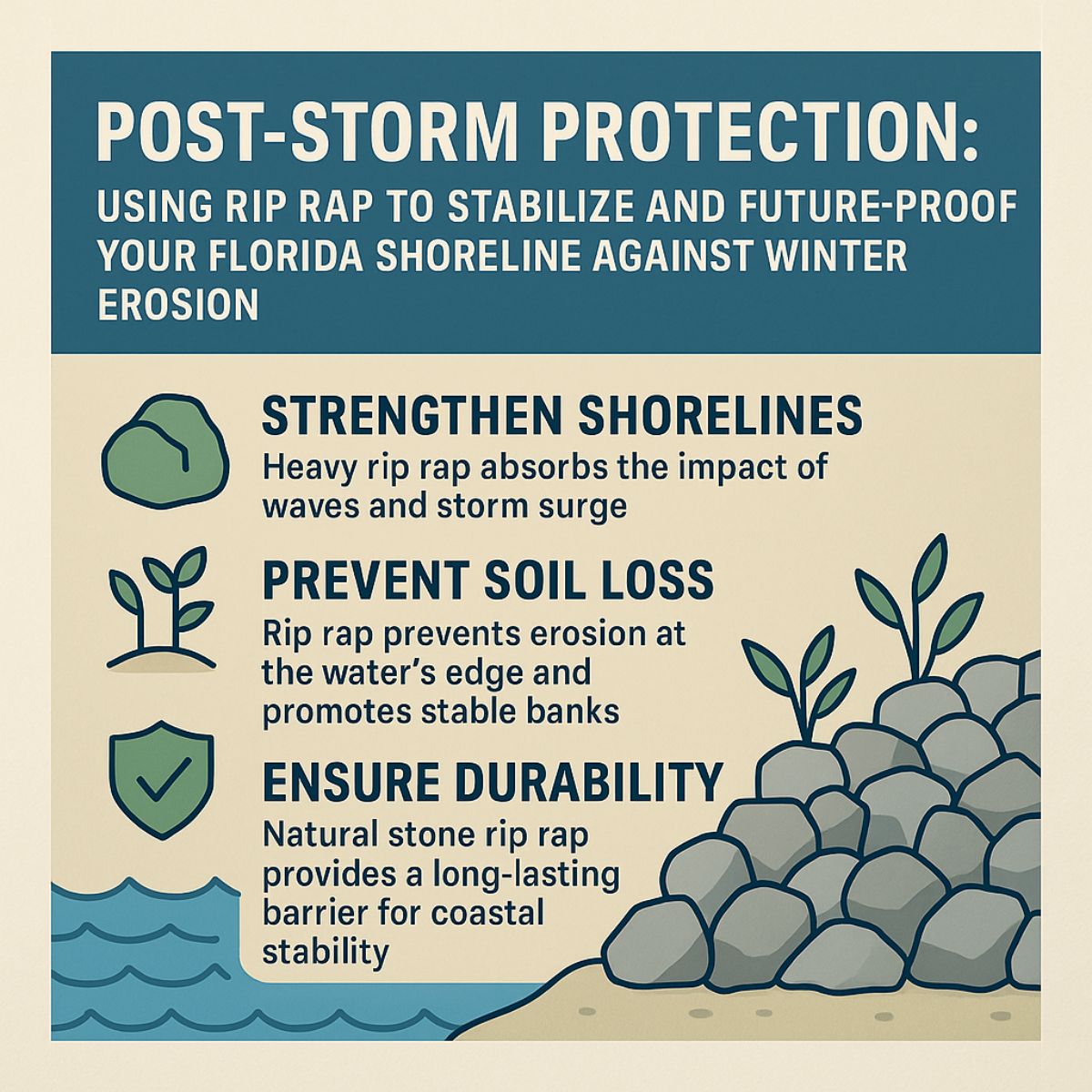The close of Florida’s hurricane season is not a signal to relax; it’s the crucial window for recovery and stabilization. If your project area, whether a municipal park, waterfront development, or coastal highway, sustained damage, now is the time to act. In this expert guide, we, as your trusted equipment partner, will outline why rip rap is the superior long-term solution for shoreline resilience and provide the technical specifications you need for a compliant, durable installation using the right equipment.
From Recovery to Resilience: Why Fall is the Ideal Time for Stabilization

Based on our decades of experience supporting Florida’s construction and environmental projects, we know that waiting until spring to address storm-related erosion is a costly mistake. Erosion doesn’t stop just because the hurricanes have passed.
The Urgency of Pre-Winter Stabilization
The post-storm period, typically late October through December, presents a dual threat:
- Saturated Soil: Heavy rainfall leaves soil highly susceptible to washouts, and weakened banks are prone to slumping.
- Increased Wave and Wind Action: Cooler-month fronts and persistent wave action continue to cut away at damaged shorelines, transforming minor washouts into major structural failures.
Immediate repair using high-quality rip rap for erosion control prevents further loss of land and stops damage from reaching vital infrastructure, turning a repair project into a future-proofing investment.
Rip Rap vs. Seawalls: A Comparative Durability Analysis for Florida Aggregates
When securing a shoreline, the choice of material and method is critical. While concrete seawalls offer a hard barrier, rip rap (armor stone), sourced from reliable Florida aggregates suppliers like Delta Aggregate, offers superior long-term, dynamic protection.
| Feature | Rip Rap (Dynamic Protection) | Concrete Seawall (Static Protection) |
| Wave Energy Management | Absorbs and dissipates wave energy, allowing water to pass through. | Reflects wave energy, often scouring the toe of the wall and destabilizing the structure. |
| Lifespan | Can last 50+ years with proper initial placement and minimal maintenance. | Typically 20–30 years; susceptible to cracking, undermining (scour), and complete failure. |
| Environmental Impact | Minimal; creates natural habitat for aquatic life; used in eco-friendly rip rap supplier projects. | High; destroys natural intertidal habitat and can accelerate erosion nearby. |
| Repair Complexity | Individual stones can be easily replaced or repositioned using standard excavators. | Requires specialized demolition and extensive concrete work; very high repair cost. |
| Ideal Application | Coastlines, riverbanks, bridge abutments, jetties, and major stabilization projects. | Areas with limited space or where a vertical barrier is strictly required. |
Key Takeaway: For long-term resilience against Florida’s wave action, our service team recommends rip rap. Its porous, flexible nature effectively dissipates the energy that would otherwise destroy a rigid wall.
FDOT & Army Corps Specs: Compliant Rip Rap Installation Checklist
A successful rip rap project hinges on using the right equipment to place the right material according to exact engineering specifications. Cutting corners on material size or slope design guarantees early failure. Our team ensures the necessary heavy equipment, from long-reach excavators to specialized grapple attachments, is ready for these demanding tasks.
Do This: Essential Specifications Checklist
Before mobilization, ensure your Florida aggregates and site preparation meet these high-trust standards, which typically align with FDOT rip rap specs and Army Corps requirements.
| Element | Specification Requirement | Equipment Consideration |
| Rock Quality/Size | Use dense, durable stone (Armor Rock/Toe Rock). Weight and diameter must match design specs (e.g., D50 size) based on expected flow/wave force. | Heavy-duty hydraulic breakers may be needed for site prep; large capacity excavator grapples are essential for placement. |
| Slope Angle | The finished slope should generally be no steeper than 1.5:1 (Horizontal: Vertical). This provides maximum stability and shock absorption. | Proper excavation and grading equipment (dozers, precision-grade excavators) is mandatory for achieving the correct angle. |
| Filter Fabric (Underlayment) | A properly specified geotextile filter fabric must be secured before rock placement. This prevents fine soil from washing out through the rock layer (a common mistake). | What to Avoid: Placing rock directly on unstable soil. Use a wide-carriage machine to minimize damage to the laid fabric during placement. |
| Rock Placement | The stone must be placed densely in a well-graded layer of specified thickness, often using specialized rock buckets or hydraulic grapples to minimize voids. | Placement must be done in a controlled, non-dumped manner to key the stone together for interlocking strength. |
What to Avoid: Common Mistakes in Rip Rap Installation
- Improper Grading: Failure to achieve the 1.5:1 slope is the most common cause of instability and future erosion behind the stones.
- Skipping the Filter Fabric: This results in soil washing away behind the rip rap, causing the entire structure to settle, fail, and require expensive rework.
- Using Non-Certified Rock: Sub-standard rock that is soft or prone to breaking down (low abrasion resistance) will quickly erode, wasting time and material.
The Right Equipment for the Job
Proper rip rap installation requires power, precision, and the right attachments. Our fleet is equipped to handle the rigorous demands of shoreline stabilization:
- Long-Reach Excavators: Essential for working from the bank to place stone accurately into the water without compromising the newly graded slope.
- Heavy-Duty Hydraulic Grapples: Used for controlled, precise placement of individual stones to ensure they interlock, maximizing the structure’s integrity and long-term durability.
- Dozers and Grade Control Systems: Necessary for preparing the subgrade to the exact design slope, which is critical for compliance and performance.
Ready to launch your post-storm recovery and stabilization project?
The window for optimal shoreline repair is closing. Don’t let the calmer winter months hide underlying erosion problems. Trust Delta Aggregate and our equipment expertise to provide you with the resources for a certified, long-lasting solution.
Contact our team today to inquire about our high-quality Florida aggregates and discuss the specialized equipment you need for compliant rip rap installation.
Visit our blog for more technical insights on achieving construction excellence.